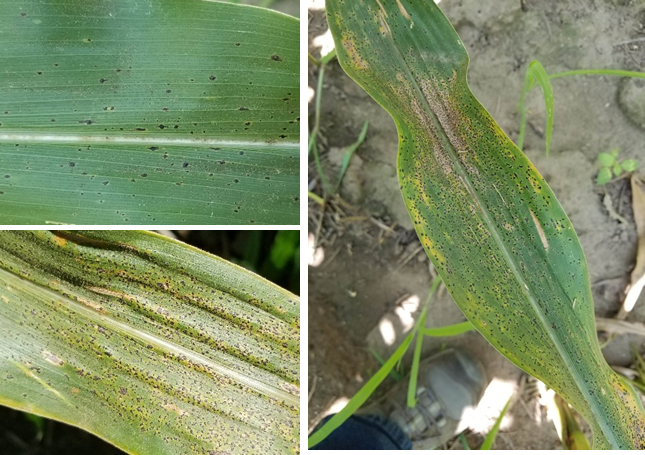Soybeans
We are starting to see a few diseases in soybean across Indiana. This week in our plots in northern, central, and southern Indiana initial foliar symptoms of sudden death syndrome are making an appearance. In addition, if we look hard we can find a few frogeye leaf spots and Septoria brown spot in the lower canopy – the levels of both of these diseases are very low and our soybeans are at R5 (beginning seed).
Corn
Tar Spot – We have confirmed 13 counties with active tar spot as of August 27 in the 2020 season (figure 1). We are starting to find multiple fields, some moderately infested with tar spot, in northern Indiana. I have scouted fields that have 100% of the plants infected with stroma (black spots) ranging from a few on a leaf to 15% severity (figure 2).

Figure 1. Map of counties confirmed for tar spot as of August 27, 2020. Orange counties have confirmed activity, gray counties where tar spot has been found in previous years.

Figure 2. Tar spot symptoms on leaves both on the lower and the upper canopy. (Photo Credit: Darcy Telenko)
Unfortunately, the sites where we are seeing the highest severity were those that were planted early and have had good moisture/irrigation all season. Luckily, at least the sites I have been in thus far, the corn has reached R5 and we hope it has minimal effect on yield. That being said, please keep a close eye on your late plantings. We have seen variable symptoms from a few stroma (black spots) on a leaf to many (figure 3).

Figure 3. Map of counties confirmed for southern corn rust in Indiana and United States as of August 27, 2020.
Southern Rust – We have added a few new counties to the southern rust map in Indiana since my last report, 24 in total with confirmed southern rust (Figure 3). Keep scouting and if you suspect it, please send a sample to the Purdue Plant Pest Diagnostic Lab (PPDL). Southern rust can cause significant yield loss if it builds up to high levels during silking and corn fill. If you’re your corn has reached R4 (milk) or beyond and you’ve just found it in a field it is unlikely southern rust will build up enough to cause yield loss. For those late planted fields, it is important to keep a close eye out for this in case a timely fungicide decision needs to be made.
We again are requesting if you have any suspect locations to please update us and send a sample. I am especially interested in those counties we have yet to scout or receive a sample. Even if your county is yellow, I am also interested in learning if you have tar spot on your farm again this and what you might be seeing – feel free to send me an email/photo at dtelenko@purdue.edu or call 765- 496-5168.


